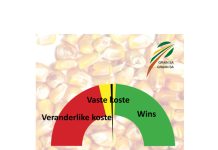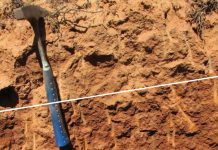



Scientific name: Commelina benghalensis
Afrikaans names: Bengaalse wandelende Jood, Bengaalse-Commelina,wandelende Jood, blouselblommetjie
English name: Benghal wandering Jew, Benghal Commelina, Wandering Jew
Short description
Benghal wandering Jew is a multi-branched, rather erect annual soft herb. It has thin roots and white underground runners (rhizomes) that also produce flowers and seeds. Stems are round, bright green, ribbed and hairy (hirtous). Although it has broad leaves, they have the typical parallel venation of monocotyledonous plants.
Leaves are simple, alternately arranged, egg-shaped (ovoid). Flowers are axillary, small, ink-blue, nearly sessile and last for only a few hours.
It has the ability to produce both aerial and subterranean flowers with seed. Fruits are capsules with three locules and contain one semi-orbicular seed in the dorsal locule and two compressed seeds in each of the other two locules.
The aerial seed is small and the subterranean seed is rather big. They are grey to nearly black and the surface of the testa is rough. Reproduction occurs in various ways, namely by means of seeds, which occur above-ground (small), as well as underground (large), and also through cuttings.
Distribution
Widespread in southern Africa, but more common in summer rainfall regions. It is regarded as difficult to control.
Because of difficult and insufficient control, this weed is rapidly increasing – especially where reduced tillage or no-tilling is practised. When occurring in dense stands, it becomes a strong competitor. Later in the season it forms a thick “matt-growth” between crop rows, especially when crops are physiologically matured making control difficult.
Control
Cultivation
Shallow hoeing with a harrow will only cut the plants in pieces and if the cuttings are not buried deeper than 50 mm, it will root and regrow. Cuttings will only die if they are buried deeper than 50 mm. Therefore shallow hoeing with a harrow will rather spread than control the weed.
Chemical
Chemical control is the best method of control for this weed. The small, subterranean seed emerges in shallow soil and pre-emergence herbicides usually gives the most effective control. The large subterranean seed can emerge as deep as 150 mm and pre-emergence herbicides gives precarious control. Therefore post-emergence herbicides gives better control of Benghal wandering Jew, while hormone type herbicides (2,4-D, dicamba and MCPA) are the most effective.
Where wandering Jew is a serious problem, the best results will be obtained by a split application of a suitable grass herbicide pre-emergence, followed by a post-emergence application of a suitable broadleaved herbicide. Wandering Jew seedlings should preferably not be sprayed around four leave stadium and no later than six leave stadium.
Several herbicides are registered for the control of wandering Jew in maize and wheat (Table 1 and Table 2). On most of the labels of the herbicides a note on the control of wandering Jew can be found and doses usually have to be increased for effective control.
TABLE 1: Herbicides registered on maize for the control of wandering jew.
| Active ingredient | Formula | Time of application |
|---|---|---|
| acetochlor | 700 g/litre 840 g/litre 900 g/litre 960 g/litre | Pre-emergence and early post-emergence of the crop |
| acetochlor/atrazine/simazine | 160/165/165 g/litre | Pre-emergence, with planting or just after planting |
| acetochlor/atrazine/terbuthylazine | 125/187,5/87,5 g/litre 150/225/225 g/litre 178,6/160,7/160,7 g/litre 250/225/225 g/litre 350/175/175 g/litre | Pre-emergence, with plant or within three days after planting. Early post-emergence, but not later than four leaf stage of the weed |
| acetochlor/EPTC | 150/350 g/litre | Pre-emergence of weed and crop |
| alachlor | 384 g/litre 480 g/litre | Pre-emergence, with planting or just after planting |
| alachlor/atrazine | 336/144 g/litre | Pre-emergence, with planting or just after planting |
| atrazine | 500 g/litre 900 g/kg | Pre-emergence, with planting or just after planting |
| atrazine/bendioxide | 200/200 g/litre | Post-emergence, between two to six leaf stage of the weed |
| atrazine/cyanazine | 167/333 g/litre 250/250 g/litre | Pre-emergence and early post-emergence of the crop |
| atrazine/mesotrione/s-metolachlor | 208,5/26,8/208,5 g/litre | Pre-emergence of the crop and weed |
| atrazine/metazachlor/terbuthylazine | 210/60/210 g/litre | Pre-emergence or within three days after plant. Post-emergence as follow-up application |
| atrazine/metolachlor | 300/300 g/litre | Pre-emergence or within three days after planting |
| atrazine/metolachlor/terbuthylazine | 174/252/174 g/litre 262,5/175/262,5 g/litre | Pre-emergence and early post-emergence, but only where grasses have not emerged yet and broadleaf weeds are not bigger than four leaf stage |
| atrazine/s-metolachlor | 370/290 g/litre | Pre-emergence, within three days after planting |
| atrazine/sulcotrione | 300/125 g/litre | Pre- or post-emergence application |
| atrazine/terbuthylazine | 250/250 g/litre 270/270 g/litre 300/300 g/litre 450/450 g/kg | Pre-emergence or early post-emergence, before broadleaf weeds have reached four leaf stage |
| bendioxide | 480 g/litre | Post-emergence, when weeds are actively growing |
| bromoxynil | 225 g/litre 450 g/litre | Post-emergence, before weeds reach six leaf stage |
| bromoxynil/terbuthylazine | 150/333 g/litre | Post-emergence |
| dicamba | 480 g/litre 700 g/litre | Post-emergence, till crop is 30 cm tall. Can also be mixed with atrazine |
| dimethenamid-P | 720 g/litre | Pre-emergence or within three days after planting |
| dicamba/topramezone | 160/50 g/litre | Early post-emergence before six leaf stage, use in tank mix with atrazine or atrazine/terbuthylazine and Dash HC |
| glyphosate/mesotrione/s-metolachlor | 250/25/250 g/litre | Post-emergence, only on glyphosate-tolerant cultivars |
| mesotrione | 480 g/litre | Pre- or post-emergence. Only use in tank mix with atrazine, atrazine/ terbuthylazine or s-metolachlor |
| mesotrione/s-metolachlor | 83,3/416,7 g/litre | Pre-emergence of weed and crop |
| metolachlor | 800 g/litre 840 g/litre 915 g/litre 950 g/litre | Pre-emergence or within three days after planting |
| metribuzin | 480 g/litre | Post-emergence, between four to six leaf stage of the weed, when weeds are actively growing |
| s-metolachlor | 915 g/litre 960 g/litre | Pre-emergence or within three days after planting |
| s-metolachlor/terbuthylazine | 312,5/187,5 g/litre | Early post-emergence, in tank mix with mesotrione |
| tembotrione | 420 g/litre | Early post-emergence, use in tank mix with Atrazine 500 SC, ammonium sulphate and Ballista |
| terbuthylazine | 600 g/kg | Pre- and early post-emergence, till four leaf stage |
TABLE 2: Herbicides registered on wheat for the control of benghal wandering jew.
| Active ingredient | Formula | Time of application |
|---|---|---|
| 2,4-D | 480 g/litre 500 g/litre 720 g/litre | Apply between growth stages seven to 13 of the crop |
| 2,4-D/dicamba | 240/80 g/litre | Apply between growth stages seven to 13 of the crop |
| bendioxide | 480 g/litre | Apply to young, actively growing weeds |
| bromoxynil | 225 g/litre 450 g/litre | Early post-emergence, before six leaf stage of the weed |
| dicamba | 700 g/kg | Use only in tank mix with Enhancer (10 g tot 12 g) and Reaper (10 g) and a wetter (adjuvant) |
| MCPA | 400 g/litre 700 g/kg | Apply between growth stages seven to 13 of the crop |
Therefore the specifications and doses for control of the wandering Jew have to be adhered to.
Always contact a reliable advisor before using any chemicals to ensure the correct dose on the label is adhered to.
Contact the writers at elbe.hugo@syngenta.com (Elbe Hugo) and, deweth@arc.agric.za (Hestia Nienaber).

















